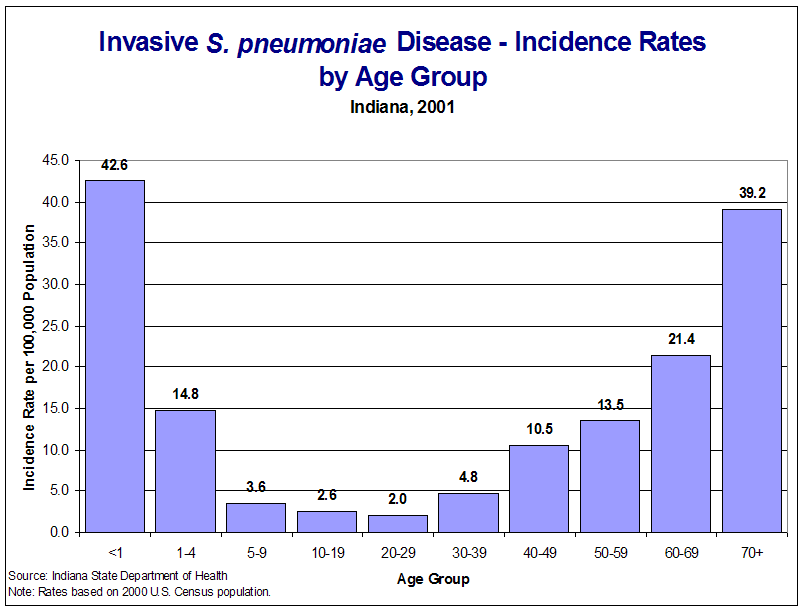Figure Strep1. Invasive S. pneumoniae Disease - Incidence Rates by Age Group, Indiana, 2001

2001 Indiana Report of Infectious Diseases |
View ISDH's Quick Facts on Pneumococcal infections
View CDC's Streptococcus pneumoniae infection page
Rates presented are per 100,000 population and are based on the U.S. 2000 Census.
| Cases | Incidence Rate |
|
| Total | 682 | 11.2 |
| Race-specific cases and rates1 | ||
| White | 476 | 8.9 |
| Black | 94 | 18.4 |
| Other2 | 3 | 1.2* |
| Sex-specific cases and rates | ||
| Female | 337 | 10.9 |
| Male | 345 | 11.6 |
Surveillance of invasive Streptococcus pneumoniae (pneumococcal disease) has been ongoing in Indiana since June 1998. Among Indiana residents of all ages, 682 unduplicated cases were reported (11.15 cases per 100,000 population) in 2001, compared to 710 unduplicated cases reported (11.68 cases per 100,000 population) in 2000.
Incidence of invasive pneumococcal disease varies considerably with age, with the highest rates occurring in children under age 1 and in adults over age 65 (Figure Strep1). There is also a strong seasonal trend in the number of reported cases, with the most cases reported in late winter and early spring, and the least in summer (Figure Strep2).
Race was identified on 573 of the reported cases. The white race was reported in 476 cases (representing 83.1% of cases where race was known) and African American or Black race was identified in 94 cases (16.4% of cases with known race). Of the 682 cases 337 (49.4%) were female and 345 (50.5%) were male.
Fifty-nine deaths were reported among the 682 cases. The outcome of 110 cases was not reported; therefore a death rate of 10.3% (59/572) was recorded for all ages where the outcome was known. The death rate for infants under age 1 with known outcome was 4.3% (1/23), a decrease from 10.4% (5/48) in 2000.
Antibiotic resistance has become an emerging world, national, and state problem in the treatment of Streptococcus pneumoniae invasive disease. In the U.S., DRSP has increased substantially in the past 15 years; DRSP varies regionally and has been reported to be over 30% in some areas of the U.S.
In Indiana during 2001, penicillin sensitivity data were received on 585 (85.8%) isolates. Of the cases where sensitivity information was available, 30.8% had either high level (16.9%) or intermediate level (13.9%) resistance to penicillin.
To better understand the resistance rates in Indiana, Table Strep1 lists the number of isolates and their sensitivity by county (only counties with 5 or more isolates are listed).
To compare data from 1999 to this table, see Appendix D of the 1999 Indiana Report of Diseases of Public Health Interest. For comparable data from 2000 see the 2000 Indiana Report of Infectious Diseases. If you do not have these reports, you can access them at the Indiana State Department of Health Website at: http://www.in.gov/isdh/dataandstats/disease/diseases_index.htm.
Sensitivity data can be compared from year to year to determine if the organism is becoming more resistant to various antibiotics. Table Strep2 shows selected antibiotics and the rates of resistance reported in 1999, 2000, and 2001. As can be seen in Table Strep2, the percent of isolates that were resistant has remained fairly stable for the three-year period, with Cefotaxime, Erythromycin, and Clindamycin showing the biggest percentage increases. It is hoped that, with increased pneumococcal conjugate vaccine use in 2002 and 2003, fewer cases will occur (particularly in those under age 2) and antimicrobial resistance will decrease.
Back to Top of Article
Back to Table of Contents
|
Figure Strep1. Invasive S. pneumoniae Disease - Incidence Rates by Age Group, Indiana, 2001 |
|
|
Back to Reference in Text
Back to Top of Article
|
Figure Strep2. Invasive S. pneumoniae Disease - Reported Cases by Month, Indiana, 2001 |
|
|
Back to Reference in Text
Back to Top of Article
|
Table Strep1. Invasive S. pneumoniae - Reported Cases and Antibiotic Sensitivity of Submitted Isolates by County, Indiana 2001 |
||||||||||||||||||||||||||||||||||||||||||||||||||||||||||||||||||||||||||||||||||||||||||||||||||||||||||||||||||||||||||||||||||||||||||||||||||||||||||||||||||||||||||||||||||||||||||||||||||||||||||||||||||||||||||||||||||||||||||||||||||||||||
|
||||||||||||||||||||||||||||||||||||||||||||||||||||||||||||||||||||||||||||||||||||||||||||||||||||||||||||||||||||||||||||||||||||||||||||||||||||||||||||||||||||||||||||||||||||||||||||||||||||||||||||||||||||||||||||||||||||||||||||||||||||||||
Back to Reference in Text
Back to Top of Article
Back to Reference in Text
Back to Top of Article
[an error occurred while processing this directive]1 - Race was unknown for 109 of the reported cases.
2 - "Other" includes American Indian/Alaska Native, Asian, Native Hawaiian/Pacific Islander, and multiracial.
* - Rate based on less than 20 cases and should be considered unstable.
Back to Table of Contents